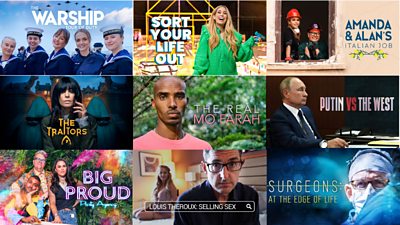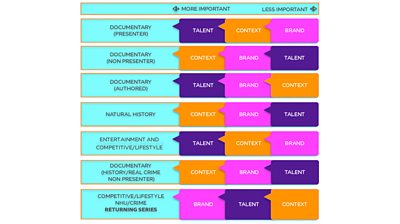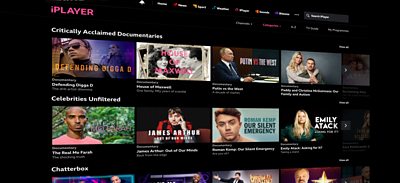There’s never been a greater choice of what to watch both on ����ý iPlayer and across the wider market, so making your programme stand out from the crowd is more important than ever. Then the show itself needs to be so good that it generates positive word-of-mouth buzz. It starts with an audacious idea or concept and ends with an enticing image that will make the viewer click.
On iPlayer, a small percentage of programmes make up around half of the overall viewing. While these ‘big hitters’ include many big factual entertainment returners that people come back to again and again, they also include titles of different shapes and sizes across all our unscripted genres.
There are helpful elements we can apply to all our programmes to maximise their success on iPlayer:
A clear hook and sell
The most critical factor is having a clear hook and promise which can be instantly communicated to the audience. If someone were to come to iPlayer knowing nothing about this show, why would they click on it? A clear and well considered title and image will help with this, as can picturing the talent. The title and image also need real clarity in terms of tone and topic.

Once a viewer chooses what to watch we need them to stick with it. We have roughly the first five minutes to hook them in, so your idea needs to start strong. Making sure that the first few minutes have enough action, interest, intrigue, warmth, or whatever the show really wants to sell to the audience is key.
On iPlayer we also need the last five minutes of a programme to be compelling enough to keEp them watching the next episode. Whether that’s a cliff-hanger end, a tease to the next episode, or a story so strong they simply must keep watching, we need ideas to have these gripping endings really factored in. What is it about your idea that will hook viewers almost instantly, and keep them coming back for more? We call this being ‘sticky’.
Longevity
A large proportion of iPlayer’s viewing is to content over a year old. From the commissioning stage we’re increasingly thinking about whether content could be evergreen and have longevity on the platform.
Different types of content perform differently over time. Some titles burn bright and fast with most of their viewing early on after release – titles like The House of Maxwell or High: Confessions of an Ibiza Drug Mule. These bring people to the platform and are often the ones that create the biggest buzz on social and in the media. They are critical to iPlayer’s success.
Then there is also the slow burn content that people watch year round regardless of when it was released, like Top Gear or QI. Often these have a familiar format that viewers can return to again and again.
Lastly, there are new series that when on air can help us reactivate content in our back catalogue. For example, people watching the first series of something in anticipation of the next. Or great talent in a new show awakening an appetite for their previous roles. Natural history landmarks do a great job at this, awakening an appetite for wildlife content from across other brands whenever a new series launches. It’s useful to think about what other content might be re-energised by your show.
When pitching, have a clear view on the expected lifecycle of your programme. Think about:
- Is it a format that people can come back to and it will still stand up in the future? If so try to avoid too many references to times of year and other things that will make it date.
- Could viewers watch more than one episode at a time? Is it something that would make sense as a bingeing proposition, something you could come back to again and again, or even rewatch?
- Are there topical moments that this will always feel relevant for? We aim for iPlayer to feel like a platform that’s responding to the world outside, so when an important moment comes up we can resurface it. Think about whether there are perennial themes inherent like wanderlust in the winter, or cleaning in the spring, or shared moments like Christmas and sporting seasons.
Catering to every mood and occasion
When people come to iPlayer they aren’t thinking about genre, what they chose to watch is based on mood and occasion, ie ‘what am I in the mood for?’ rather than ‘what do I want to watch?’. If a viewer wants to relax, they might choose a long running comedy or a familiar entertainment show. If they want to engage their brain they might choose a hard-hitting drama or a documentary.
On iPlayer, we speak directly to those needs through our homepage curation. We have a constantly evolving range of collections to help group content by mood and occasion. Recently we’ve had success with ‘Epic Adventures’, ‘Secrets and Scandal’, ‘Critically Acclaimed’ and ‘Amazing Transformations’ collections.
When you’re thinking about the show you’re pitching think about how we might curate it and what else it would sit well next to. How could it relate to the other content on iPlayer across all different genres? We’d like to hear about this when you're pitching to us.
Communicating the mood of your programme to audiences through look and feel and talent is once again vital for someone who’s coming to your programme with zero knowledge, so think about how the title, image and description can reflect this. Carefully consider what pictorial elements typify the mood of your show. A considered colour pallet, talent portrait, or well-crafted title can signal this as much as a description of the content. Find out more about how to use powerful images to increase the impact of your show on iPlayer below.
Understanding your target audience
Generally, shows with the biggest impact on iPlayer are timely and highly relevant to their target audience. Success therefore requires a real understanding of that audience and absolute clarity around how the programme will resonate with them - be that the subject, talent, unique angle or the way the story is told. We want to see that level of understanding in the ideas we receive and will work closely with producers to achieve this.
Titles
When choosing a programme title firstly consider who your target audience is. Are they in-the-know and will instantly grasp the subject with a few key words, or are you aiming for a general audience who know nothing about the subject? Don’t be too mysterious.
For example, Roman Kemp: Our Silent Emergency relied on the audience knowing the talent and therefore being able to guess the emergency. It relied on an in-the-know audience.
Big Proud Party Agency had a fun title that sets clear expectations for the show to a general audience.
For iPlayer, shorter titles also work best. Long titles get cut off, which reduces their impact and the information an audience will need when deciding whether to watch the show. They can also be harder to place on top of an image.
More information about titles can be found in the
Images
Images are absolutely vital for a programmes success on iPlayer. The right image can lead to a 40% increase in those clicking on a title.
The human brain can process images in as little as 13 milliseconds. This means your image needs to instantly convey:
- A clear sense of tone – how’s it going to make someone feel?
- A clear sense of topic – what’s the programme about?
- A clear sense of talent – who’s in it?
Choosing what to feature in the programme image also depends on the genre. For example, for entertainment the talent will often sell the show best to a potential audience, while true crime style documentaries can gain the most traction by focussing more on the context around the story.
We've analysed what elements can work best to sell a show show based on it's genre - whether that's context, character, talent or the brand itself. This can be found in our iPlayer unscripted image guide (pdf), and on the image below.

Size also matters. A thumbnail image will appear quite small on the iPlayer homepage so think about what image will instantly convey the main sell of your programme, without relying on extensive detail or multiple protagonists in frame.
For detailed guidance on ensuring your images have impact on iPlayer, see the links below. Further guidance on delivering stills can also be found on the Production and delivery website.
Programme descriptions
Written programme descriptions on iPlayer play a huge role in enticing people to watch. Audiences will rely on this description to decide if they want to click on your programme or not. Does your description give an instant sense of the content, tone and experience of the programme, and help distinguish it from other content out there?
It’s also important to assume the audience has never heard of the programme before they come across it on iPlayer, so consider how the description sells your programme to a brand new viewer.
When thinking about programme descriptions ask whether it communicates the programme hook - be that subject, talent or tone – and puts the most important bits of information first. And is that sell clear, short and simple enough to grasp within a few seconds of reading?
For detailed guidance on what you need to deliver for each programme see the iPlayer programme descriptions guide below along with the billings section of the ����ý Production and delivery website.
Commissioning
All ideas should be pitched to the appropriate genre team, including those exclusively for iPlayer with no channel TX. Find contacts and genre briefs for all of unscripted on the links below.
For plain text versions of any of the guides featured on this page, please email us.
Explore the site
-
Briefs and contacts
Commissioners and ideas -
Supporting indies
How we commission and work -
Skills and training
Industry training and skills development



